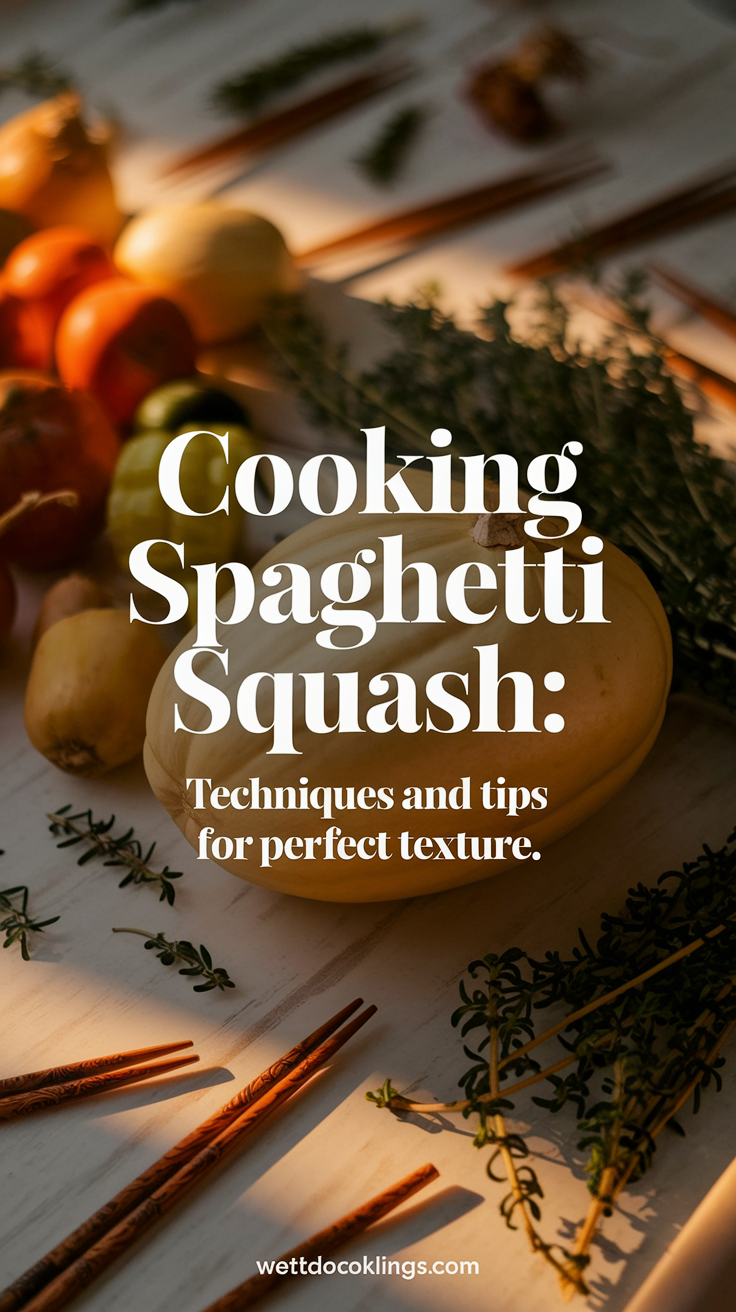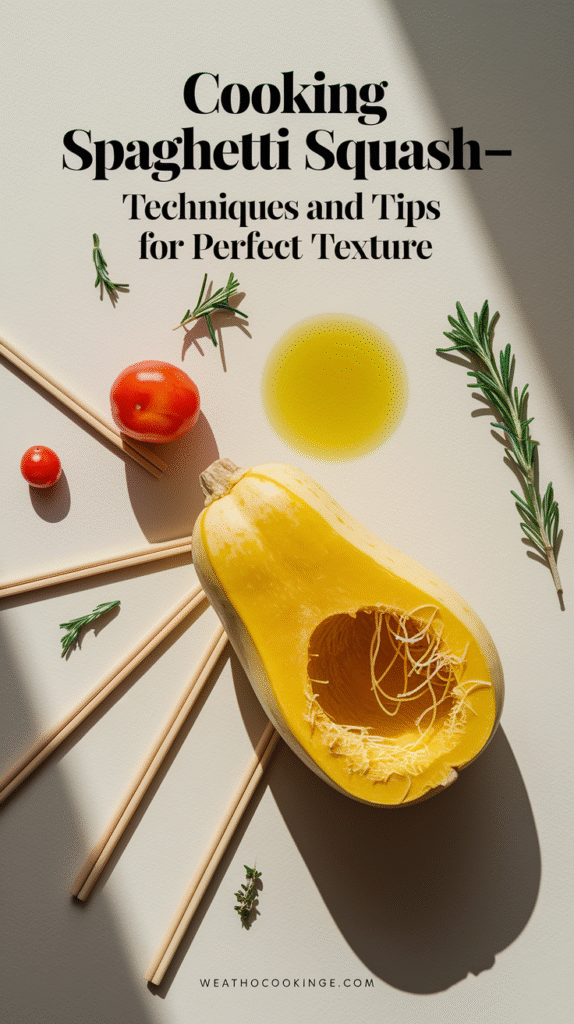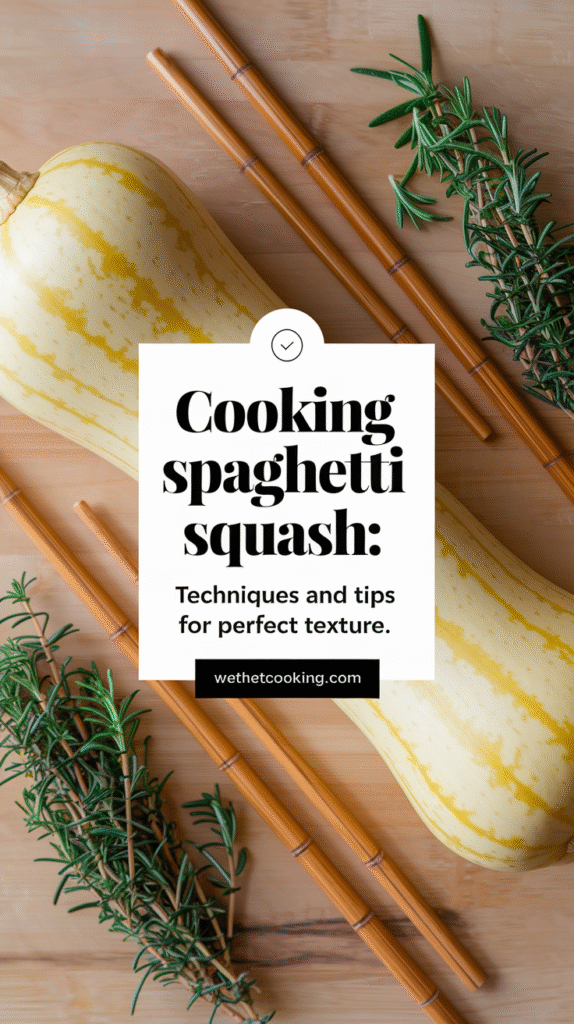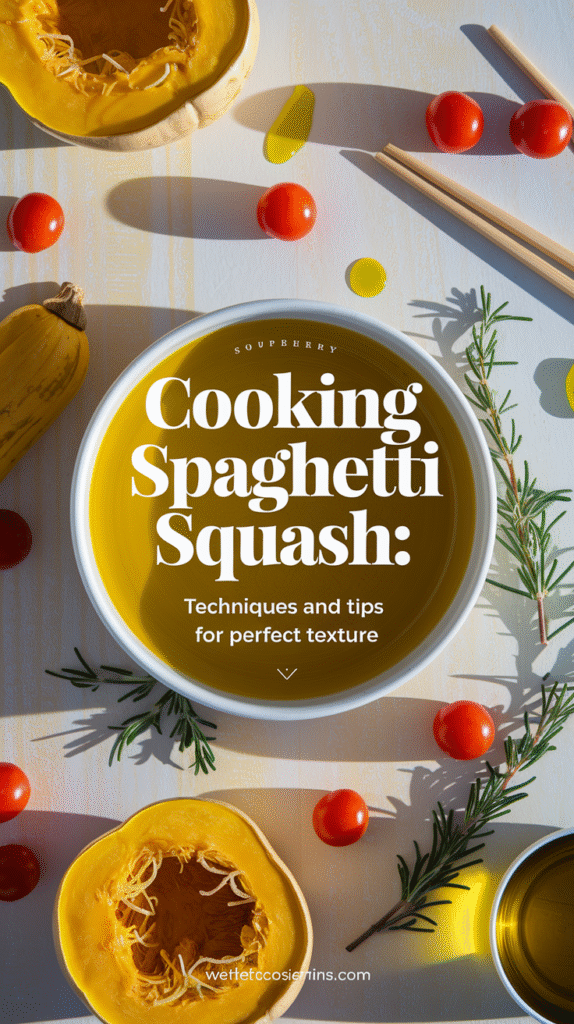Cooking spaghetti squash can open up a world of culinary creativity while offering a healthy alternative to traditional pasta. Known for its unique stringy texture and mild flavor, this winter squash is not only nutritious but also versatile. Here are some techniques and tips to ensure you achieve the perfect texture every time you cook spaghetti squash.
Choosing the Right Spaghetti Squash
Before cooking, it’s crucial to select the right spaghetti squash. Look for the following:
- Weight: Choose a heavy squash for its size; it indicates moisture content and ripeness.
- Skin: The skin should be hard and yellow, with no blemishes or soft spots.
- Shape: Opt for a squash with a symmetrical shape. This usually means a uniform cooking texture.
Preparation Techniques
Proper preparation is key to achieving the best texture when cooking spaghetti squash. Here are some effective methods:
1. Roasting
One of the most popular methods is roasting. This enhances the natural sweetness of the squash and gives it the ideal texture. Follow these steps:
- Preheat your oven to 400°F (204°C).
- Cut the spaghetti squash in half lengthwise. Use a sharp knife to avoid injury.
- Scrape out the seeds and loose pulp with a spoon.
- Drizzle olive oil on the flesh and season with salt and pepper.
- Place the halves, cut side down, on a baking sheet lined with parchment paper.
- Roast for 40-45 minutes, or until the edges caramelize and the flesh becomes tender.
2. Microwave Cooking
If you’re short on time, using a microwave can be an efficient option. Here’s how to do it:
- Pierce the squash multiple times with a fork to allow steam to escape.
- Place the whole squash in the microwave and cook on high for 10-12 minutes, flipping halfway through.
- Once cooled, cut the squash, remove seeds, and scrape with a fork to create “spaghetti”.
3. Boiling
Boiling is another method that can yield good results, though it may slightly alter the texture.
- Cut the spaghetti squash into quarters. Remove the seeds.
- Add to a large pot of boiling salted water.
- Cook for about 10-15 minutes until tender.
- Drain and scrape the flesh with a fork.
Achieving the Perfect Texture
Regardless of your cooking method, achieving the ideal spaghetti squash texture relies on a few important factors:
- Don’t Overcook: Keep an eye on cooking times. Overcooking can lead to mushy squash.
- Let it Rest: After cooking, let the squash rest for a few minutes before scraping. This allows the steam to finish cooking the insides.
- Scrape Correctly: Use a fork to carefully scrape the flesh into strands, creating that desirable spaghetti-like texture.
Serving Suggestions
Once you’ve cooked spaghetti squash to perfection, consider the following serving ideas:
- With marinara sauce: Classic and simple, top it with your favorite marinara for a dish reminiscent of spaghetti.
- In a stir-fry: Add cooked squash to veggie stir-fries for a nutritious boost.
- With pesto: Toss with fresh pesto for a flavorful twist.
- As a salad base: Use cold spaghetti squash as a base for salads, topped with fresh vegetables and dressing.
For more information on spaghetti squash recipes and nutritional benefits, check out Love and Lemons.
With these techniques and tips in mind, you’re now equipped to cook spaghetti squash perfectly. Enjoy this healthy, delicious alternative to pasta in countless ways!
Nutritional Benefits of Spaghetti Squash Compared to Traditional Pasta
You might be curious about the nutritional benefits of spaghetti squash compared to traditional pasta. Spaghetti squash is a unique vegetable that has gained popularity, particularly among those looking for healthier alternatives. It offers a host of benefits that set it apart from conventional grain-based pasta. Let’s dive into what makes spaghetti squash a smart choice for your diet.
First, one of the most significant advantages of spaghetti squash is its low calorie content. A cup of cooked spaghetti squash contains about 42 calories, whereas the same serving of cooked traditional pasta contains around 200 calories. This substantial difference can help you reduce your overall calorie intake, making it easier to maintain or lose weight.
Another striking difference is in carbohydrate content. Spaghetti squash has roughly 10 grams of carbohydrates per cup, while pasta can boast about 40 grams. For those managing their carbohydrate intake, especially individuals with diabetes or those following low-carb diets, spaghetti squash makes an excellent alternative.
- Calories: Spaghetti squash: 42 kcal, Traditional pasta: 200 kcal
- Carbohydrates: Spaghetti squash: 10 g, Traditional pasta: 40 g
- Fiber: Spaghetti squash: 2 g, Traditional pasta: 2 g
Fiber is important for digestive health, and both spaghetti squash and traditional pasta offer similar amounts. However, spaghetti squash includes a higher content of water, which adds to its weight without adding calories. This feature can enhance satiety, making you feel full longer without overeating.
One of the most important aspects of any food is its nutritional density. When comparing vitamins and minerals, spaghetti squash shines brightly. It is rich in Vitamin A and Vitamin C, crucial for immune function and skin health. A single serving can provide around 5% of your daily recommended intake of calcium and iron, which are important for bone health and oxygen transport in the blood, respectively.
| Nutrient | Spaghetti Squash (1 cup) | Traditional Pasta (1 cup) |
|---|---|---|
| Calories | 42 | 200 |
| Carbohydrates | 10 g | 40 g |
| Fiber | 2 g | 2 g |
| Vitamin A | 5% DV | 0% DV |
| Vitamin C | 9% DV | 0% DV |
What about the flavor? Spaghetti squash has a mild taste that easily absorbs sauces and seasonings, making it a versatile dish component. You can enjoy it simply with olive oil and garlic or top it with marinara sauce or pesto. The neutral flavor profile means it can complement a variety of cuisines.
For those seeking gluten-free options, spaghetti squash is an obvious choice. Traditional pasta often contains gluten, which can be problematic for individuals with celiac disease or gluten sensitivity. By switching to spaghetti squash, you can indulge in comforting “pasta dishes” without the potential side effects associated with gluten.
Cooking spaghetti squash is simple and can be done in several ways—roasting, microwaving, or even boiling. Each method enhances the flavor and preserves the nutrients. To roast, simply cut the squash in half, remove the seeds, drizzle with olive oil, and bake until tender. Once cooked, scrape the flesh with a fork to create spaghetti-like strands.
Spaghetti squash into your meals can add variety to your diet. You can substitute it in traditional pasta recipes or use it as a base for hearty meals. It pairs well with proteins like grilled chicken or shrimp and offers a wonderful texture that makes every dish satisfying.
Spaghetti squash is a fantastic choice for those aiming to enhance their nutrition without compromising on flavor or satisfaction. By opting for this nutritious vegetable over traditional pasta, you can enjoy a lower-calorie, nutrient-dense alternative that fits well into a balanced diet. For more insights on healthy eating, visit Healthline and EatingWell. Embrace the benefits of spaghetti squash and transform your meals today!
Creative Recipes Featuring Spaghetti Squash as a Main Ingredient
Spaghetti squash is an incredibly versatile vegetable that serves as a fantastic base for a variety of dishes. Rich in vitamins and low in calories, it has become a popular choice for those seeking healthy meal options. Let’s explore some creative recipes that highlight spaghetti squash as a main ingredient, offering both flavor and nutrition.
Cooking spaghetti squash can be simple and rewarding. This unique vegetable, when cooked, breaks down into spaghetti-like strands, making it a perfect substitute for traditional pasta. Here are some delicious recipes to inspire you in the kitchen.
Spaghetti Squash Primavera
This vibrant dish packed with vegetables brings spring flavors to your table. To prepare, follow these steps:
- Start by roasting the spaghetti squash in the oven. Cut it in half, scoop out the seeds, drizzle with olive oil, and season with salt and pepper. Bake at 400°F (200°C) for about 45 minutes.
- In a pan, sauté a mix of bell peppers, zucchini, and cherry tomatoes in olive oil. Add minced garlic and cook until fragrant.
- Once the spaghetti squash is cooked, scrape out the strands and toss them with the sautéed vegetables. Finish with a sprinkle of parmesan cheese and fresh basil.
Spaghetti Squash with Pesto and Grilled Chicken
This recipe offers a hearty meal while staying healthy. It combines the nutty flavor of pesto with tender grilled chicken. Here’s how to make it:
- Prepare the spaghetti squash by roasting it as mentioned earlier.
- While it bakes, marinate chicken breast in your favorite pesto sauce, then grill until fully cooked.
- Once the squash is ready, mix the strands with additional pesto, sliced grilled chicken, and cherry tomatoes for freshness.
- Serve with a drizzle of balsamic glaze and a handful of arugula for a vibrant presentation.
Spaghetti Squash Carbonara
This innovative take on the classic carbonara makes use of spaghetti squash and eliminates the need for heavy pasta. Here’s how to create this creamy dish:
- Begin by cooking the spaghetti squash as detailed before.
- In a skillet, cook diced bacon until crispy. Remove and set aside.
- Add eggs and Parmesan cheese into a mixing bowl, whisking well. Slowly stir in cooked spaghetti squash, allowing the heat to slightly cook the eggs and create a creamy sauce.
- Add the crispy bacon and season with black pepper. Toss until well-combined.
Spaghetti Squash Taco Bowls
Transform taco night with this gluten-free alternative. These bowls are fun and customizable:
- Roast the spaghetti squash as before.
- In a skillet, cook ground turkey or beef with taco seasoning.
- To assemble your taco bowl, layer spaghetti squash, the meat mixture, diced avocado, chopped cilantro, and salsa. Finish with a squeeze of lime.
Spaghetti Squash Mac and Cheese
This comfort food classic gets a wholesome makeover with spaghetti squash. Here’s how to make it:
- Prep the spaghetti squash in the oven.
- In a saucepan, prepare a cheese sauce with cheddar, milk, and a bit of flour. Stir until thick and creamy.
- Mix the cheese sauce with the spaghetti squash strands and pour into a baking dish.
- Top with breadcrumbs and additional cheese, then bake at 350°F (175°C) until golden.
How to Cook Spaghetti Squash
If you’re new to cooking spaghetti squash, here’s a quick guide:
| Method | Description |
|---|---|
| Roasting | The most common method. Bake cut squash at 400°F for 30-45 minutes. |
| Microwave | Quick and easy! Poke holes in a whole squash and microwave for 10-12 minutes. |
| Instant Pot | Place half a squash with a cup of water in the pot. Cook on high for 7 minutes. |
With these recipes and the cooking methods outlined, you’re well on your way to enjoying delicious meals with spaghetti squash as the star ingredient. For more recipes and cooking tips, you can visit Love and Lemons or Whole Foods Market for inspiration.
Don’t hesitate to experiment with your own flavors and pairings using spaghetti squash. Not only is it nutritious, but it also offers a wonderful base for countless culinary creations. Enjoy your cooking adventures!
Common Mistakes to Avoid When Cooking Spaghetti Squash
Cooking spaghetti squash can be a delightful culinary adventure, but there are a few common mistakes that can turn a promising dish into a disappointing experience. Understanding these pitfalls can significantly enhance your success when preparing this unique vegetable, allowing you to enjoy its delicious flavor and health benefits.
One major mistake is not selecting the right spaghetti squash. When shopping for this vegetable, look for one that is firm with a smooth, golden exterior. Avoid squash with soft spots or blemishes, as these indicate over-ripeness or spoilage. A vibrant yellow color is a good sign, while dull or green patches may suggest immaturity.
Another mistake people often make is failing to wash the spaghetti squash properly before cooking. Just like any other produce, it’s essential to rinse the outer skin under cold water to remove dirt and potential bacteria. This step is crucial, especially if you plan to cut the squash in half, as it prevents contaminants from entering the edible flesh.
Many cooks struggle with the right cooking method for spaghetti squash. Common techniques include baking, microwaving, and steaming. However, one of the most frequent errors is overcooking the squash. When it’s overcooked, spaghetti squash can become mushy rather than retain its signature spaghetti-like strands. Aim to cook until the flesh is just tender, and test by piercing it with a fork; the strands should separate easily but still have a slight bite.
It’s equally important to properly cut the squash before cooking. Some people mistakenly attempt to cut it in half lengthwise, which can be challenging and dangerous due to its tough skin. A better approach is to pierce the squash several times with a sharp knife and microwave it for a few minutes first. This softens the skin, making it much easier and safer to cut in half.
Once you have your spaghetti squash prepared, some may overlook how to season it effectively. Don’t be shy with your seasonings! A light drizzle of olive oil, a sprinkle of salt, and a dash of pepper can elevate the flavor. Consider including herbs like oregano or basil for added depth. The goal is to highlight the squash’s natural flavors without overpowering them.
Moreover, after cooking, it’s essential to scrape the squash correctly. Use a fork and gently pull the flesh from the skin to create the long strands that give spaghetti squash its unique texture. Some people may rush this step, resulting in a mushy mix. Take your time to separate the strands gently, preserving their shape and texture.
Here’s a quick checklist of common mistakes to avoid:
- Selecting an under- or overripe squash
- Neglecting to wash the squash
- Overcooking or undercooking the squash
- Improper cutting methods
- Insufficient seasoning after cooking
Also, don’t forget about the versatility of spaghetti squash. Many people stick to traditional Italian seasonings, but this vegetable can adapt to various cuisines. Consider using Asian-style sauces or Mexican spices to create an entirely different experience. The variety can make each cooking session fresh and exciting.
You may want to maintain the health benefits of the squash as well. Spaghetti squash is low in calories and rich in vitamins A and C. Understand that the nutrition can be compromised if you allow it to become overly mushy. Aim for a texture that retains some crunch while still being tender; it enhances the nutritional profile and keeps the dish appealing.
If you wish to dive deeper into cooking techniques and recipes, websites like Food Network and Allrecipes can provide you with a multitude of helpful resources. These sites offer a breadth of ideas, ranging from simple cooking instructions to elaborate dishes that feature spaghetti squash.
By avoiding these common mistakes, you can elevate your cooking game and make spaghetti squash a highlight of your meals. Embrace the versatility, and enjoy experimenting with flavors, textures, and techniques to find what best suits your palate!
The History and Popularity of Spaghetti Squash in Modern Cuisine
Spaghetti squash has rapidly gained popularity in modern cuisine, especially among health-conscious eaters and gluten-free enthusiasts. This unique vegetable, which resembles a large yellow squash, is typically characterized by its long, noodle-like strands that form when cooked. Let’s delve into its intriguing history and why it has become a staple in many kitchens around the world.
The origins of spaghetti squash date back to the early 19th century. Although it is believed to have derived from native plants in the Americas, it was not until the 1970s that it began to gain recognition in mainstream cooking. In the United States, it first appeared in California and quickly caught the attention of home cooks looking for nutritious and versatile alternatives to traditional pasta.
What sets spaghetti squash apart from other vegetables is its unique culinary characteristics. When cooked, the flesh of the squash transforms into long strands that bear a striking resemblance to spaghetti. This transformation occurs through the process of cooking, whether by baking, boiling, or steaming. As a result, it has become a favored substitute for pasta in various dishes, particularly for those seeking lower carbohydrate options.
One of the most appealing aspects of spaghetti squash is its nutritional profile. Here’s a quick look at some of its prominent health benefits:
- Low in Calories: One cup of cooked spaghetti squash contains only about 42 calories, making it a perfect choice for weight-conscious individuals.
- High in Fiber: It is rich in dietary fiber, promoting digestive health and helping control hunger.
- Rich in Vitamins: Spaghetti squash is a good source of vitamins A, C, and B6, essential for maintaining overall health.
- Antioxidants: Contains various antioxidants that help combat inflammation and oxidative stress.
Over the decades, spaghetti squash has maintained its position in the culinary spotlight, especially during the rise of plant-based and gluten-free diets. Cooking spaghetti squash has become not just a trend, but a way to incorporate more vegetables into meals without sacrificing flavor. Food bloggers and chefs alike have embraced this squash, sharing creative recipes that highlight its versatility.
Common ways to prepare spaghetti squash include:
- Baked: Cut in half lengthwise, drizzled with olive oil, and seasoned. Bake until tender, then scrape out strands with a fork.
- Boiled: Cut into smaller pieces and boiled until soft. This method is quicker but may require careful handling to maintain strand integrity.
- Microwaved: An easy option for those short on time. Place the squash in the microwave for a quick cook with excellent results.
- Spiralized: Utilizing a spiralizer can mimic varying noodle shapes, offering a fun twist for creative dishes.
In recent years, social media platforms have further propelled the popularity of spaghetti squash. Recipes featuring the squash have gone viral, showcasing everything from classic marinara dishes to innovative casseroles and salads. The visual appeal of the dish, paired with the nutritional benefits, has made it a favored topic among food influencers and health enthusiasts alike.
Chefs and home cooks have experimented with flavors to create delectable spaghetti squash dishes. You can find delicious recipes featuring this squash on sites like Food Network and AllRecipes, where you’ll be inspired to try something new.
While spaghetti squash has matured into a celebrated food item, it remains a favorite for its simplicity and healthy offerings. The versatility of this enhance cooking squash allows it to pair beautifully with various sauces, proteins, and vegetables, catering to different tastes and dietary preferences. It can be stuffed, incorporated into soups, or even used as a bed for proteins like chicken or fish.
The rising trend of incorporating vegetables into every meal highlights the importance of options like spaghetti squash. With its combination of nutrition, flavor, and ease of preparation, it’s no wonder this unique squash has carved out a special place in modern cuisine. Whether you’re looking for a healthier option or simply want to enjoy a delicious meal, learning how to cook spaghetti squash opens up a world of culinary possibilities.
Conclusion
Cooking spaghetti squash can transform your meals in exciting and healthy ways. By mastering techniques and tips to achieve the perfect texture, you’ll elevate your dishes to a new level. With its rich nutritional profile, spaghetti squash often outshines traditional pasta, offering a low-calorie, vitamin-packed alternative that can fit seamlessly into various diets.
Trying out creative recipes featuring spaghetti squash not only enhances your culinary repertoire but also adds a unique flair to your dining experience. From savory casseroles to vibrant stir-fries, the versatility of spaghetti squash allows you to experiment while enjoying its delightful taste and health benefits. However, avoiding common mistakes—like overcooking or choosing the wrong cooking method—will ensure optimal results every time.
Understanding the history of spaghetti squash offers valuable insight into its rising popularity in modern cuisine. As more people seek healthier meal options and embrace plant-based foods, it’s no wonder that this simple vegetable has found its place on menus around the world.
Whether you are a seasoned cook or just starting, incorporating spaghetti squash into your meals can lead to delicious and nutritious outcomes. So grab a squash, roll up your sleeves, and dive into the world of spaghetti squash cooking. With trial and creativity, you’re bound to find something that not only satisfies your palate but also supports a healthier lifestyle. Enjoy the process, and savor every bite!







Leave a Reply